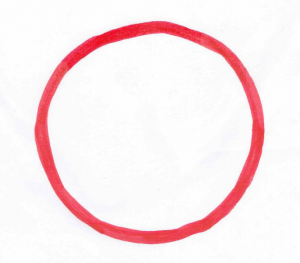By: Lindsay Barret MS, CCC-SLP
This visual is as simple as it gets- a circle drawn on a piece of paper! This can be used for groups and individual speech therapy sessions to help children keep their bodies and minds present in the group, whether the group is multiple children or the child and therapist in a 1:1 ratio.

These ideas of group membership and “keeping our bodies in the group” are based on speech-language pathologist Michelle Garcia Winner’s Social Thinking framework. Being present in the group means that the child is physically part the group, rather than moving away to another part of the room. Being physically part of the group requires facing the group member(s), maintaining a calm and quiet body, establishing eye contact with communication partner(s), and sitting in an age-appropriate manner.
It is important to recognize that not only do children need to be physically present with their communication partners, but they also need to be a part of the communicative exchange cognitively. To engage in an effective interaction, children must maintain the topic of conversation, take turns communicating, listen to their partner(s), and provide relevant comments/ questions. All of this requires joint attention, perspective taking, executive functioning, and theory of mind as foundational skills. Theory of mind is the concept that other individuals have thoughts and feelings that may differ from your own. Use of theory of mind develops in early childhood.
To use this visual support, place small pieces from a game, Legos®, or Play-Doh, for example, to represent the number of people in the group. Then move a piece out of the circle if a group member is not in the group, whether that be physically or cognitively. This serves as a visual reminder that one or more children who have left the group are acting differently than the other children in the group. It helps make the abstract concept of group membership and communicative exchanges more concrete.
Often, children are motivated to re-enter the group when they see that their piece on the circle is different from others’ pieces. The visual of all pieces on the circle helps to reinforce the concept of group membership as well.
It is recommended to laminate the paper to increase the lifespan of this useful tool. When using this visual, keep it in a place where all group members can see it. It can be used for children of all ages who have difficulty with attention, topic maintenance, perspective taking, keeping a calm body, turn taking, and responding to bids for communication.
Have you used a visual like this before? Let us know how! If you have questions about how to use a visual support such as the one above or would like to know if your child is an appropriate candidate for this tool, please contact us. We’d love to hear from you!

